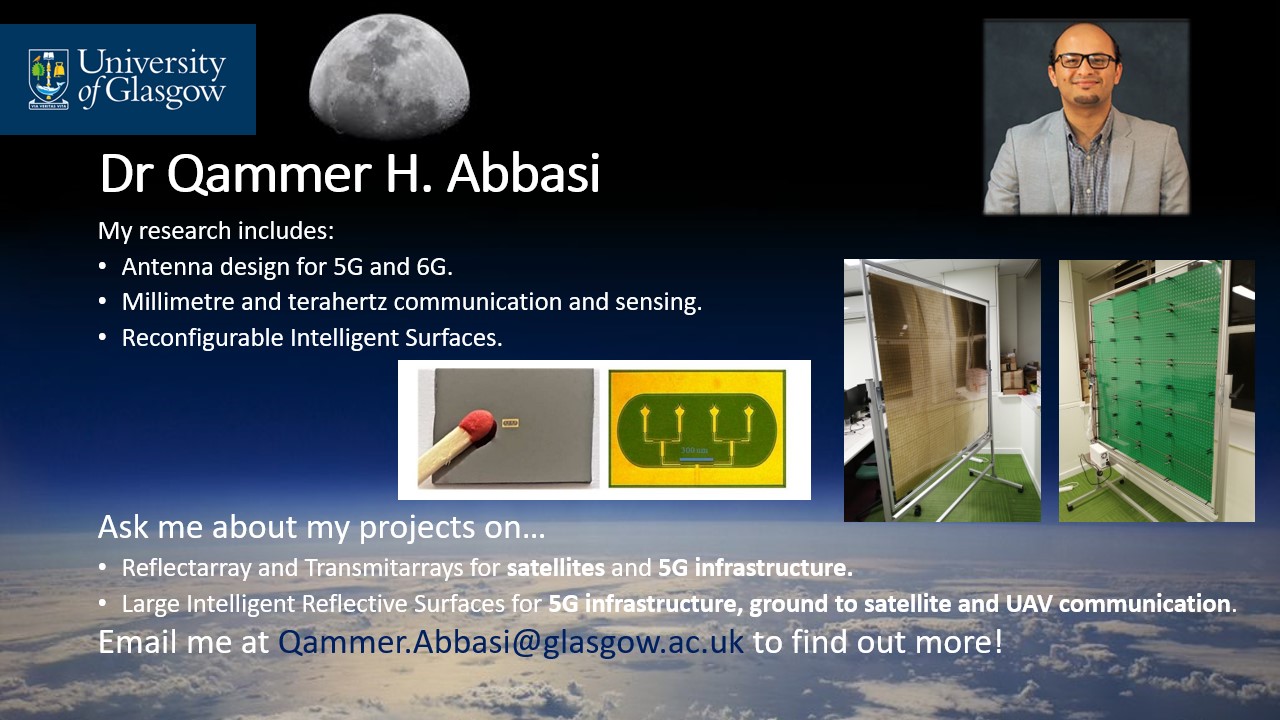
Dr Qammer H. Abbasi
My research includes:
- Antenna design for 5G and 6G.
- Millimetre and terahertz communication and sensing.
- Reconfigurable Intelligent Surfaces.
Projects
- Reflectarray and Transmitarrays for satellites and 5G infrastructure.
- Large Intelligent Reflective Surfaces for 5G infrastructure, ground to satellite and UAV communication.
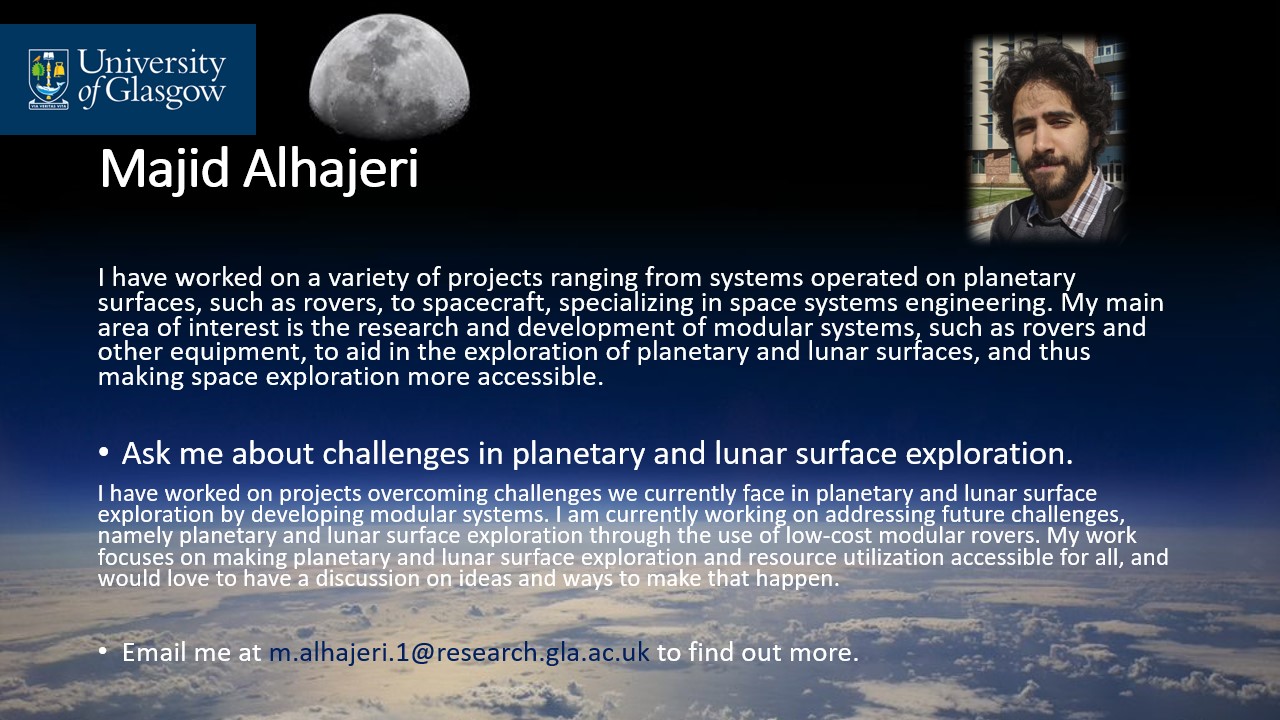
Majid Alhajeri
I have worked on a variety of projects ranging from systems operated on planetary surfaces, such as rovers, to spacecraft, specializing in space systems engineering. My main area of interest is the research and development of modular systems, such as rovers and other equipment, to aid in the exploration of planetary and lunar surfaces, and thus making space exploration more accessible.
Ask me about challenges in planetary and lunar surface exploration.
I have worked on projects overcoming challenges we currently face in planetary and lunar surface exploration by developing modular systems. I am currently working on addressing future challenges, namely planetary and lunar surface exploration through the use of low-cost modular rovers. My work focuses on making planetary and lunar surface exploration and resource utilization accessible for all, and would love to have a discussion on ideas and ways to make that happen.
- Email me at m.alhajeri.1@research.gla.ac.uk to find out more.
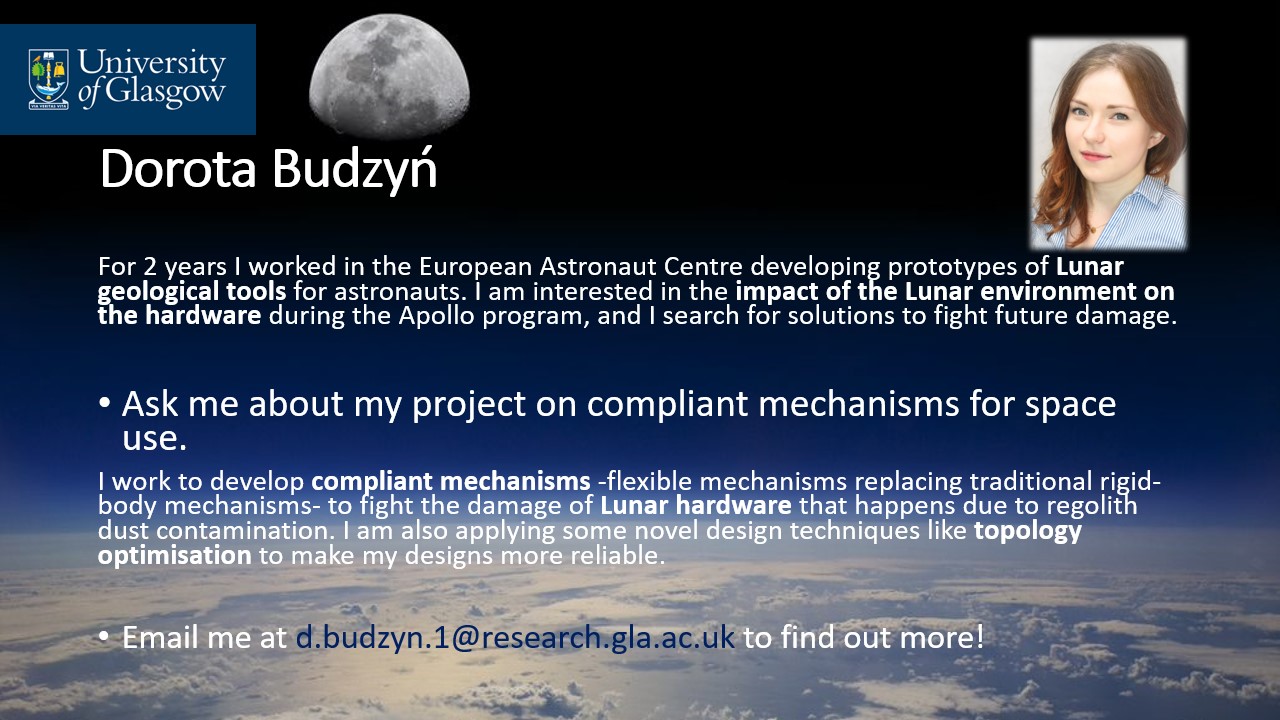
Dorota Budzyn
For 2 years I worked in the European Astronaut Centre developing prototypes of Lunar geological tools for astronauts. I am interested in the impact of the Lunar environment on the hardware during the Apollo program, and I search for solutions to fight future damage.
Ask me about my project on compliant mechanisms for space use.
I work to develop compliant mechanisms -flexible mechanisms replacing traditional rigid-body mechanisms- to fight the damage of Lunar hardware that happens due to regolith dust contamination. I am also applying some novel design techniques like topology optimisation to make my designs more reliable.
Email me at d.budzyn.1@research.gla.ac.uk to find out more
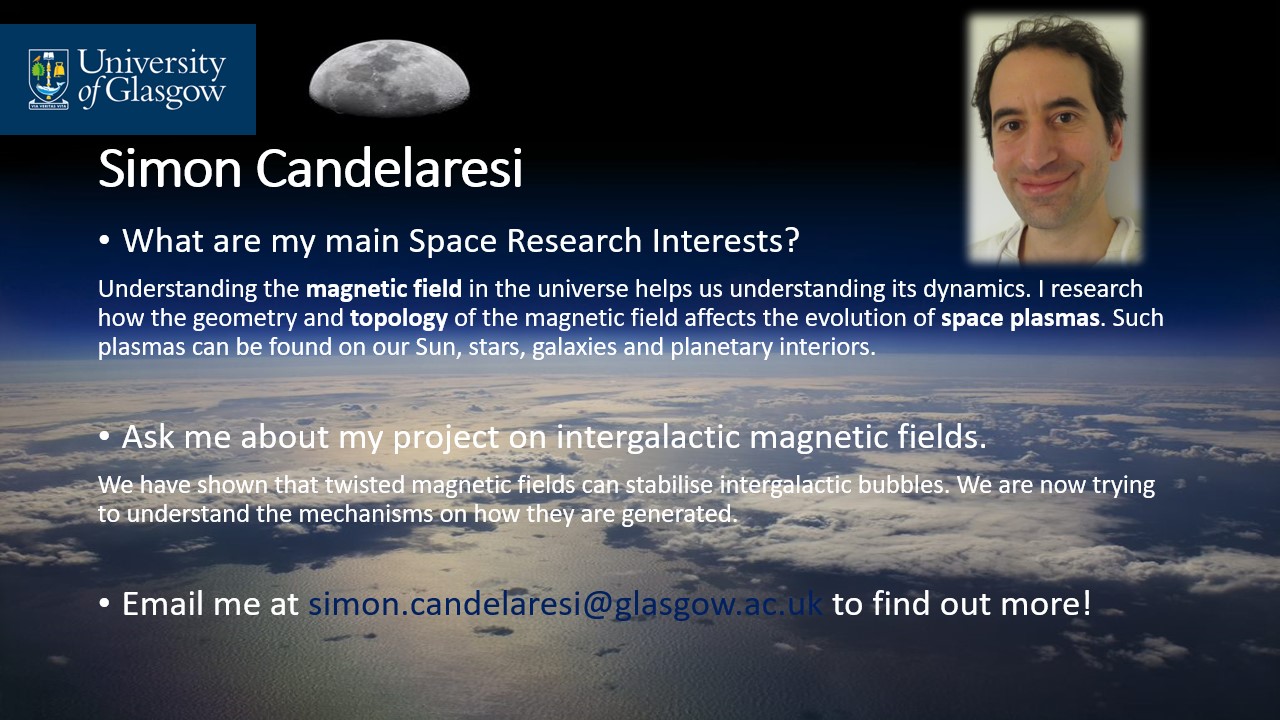
Dr Simon Candelaresi
Understanding the magnetic field in the universe helps us understanding its dynamics. I research how the geometry and topology of the magnetic field affects the evolution of space plasmas. Such plasmas can be found on our Sun, stars, galaxies and planetary interiors.
Intergalactic magnetic fields
We have shown that twisted magnetic fields can stabilise intergalactic bubbles. We are now trying to understand the mechanisms on how they are generated.
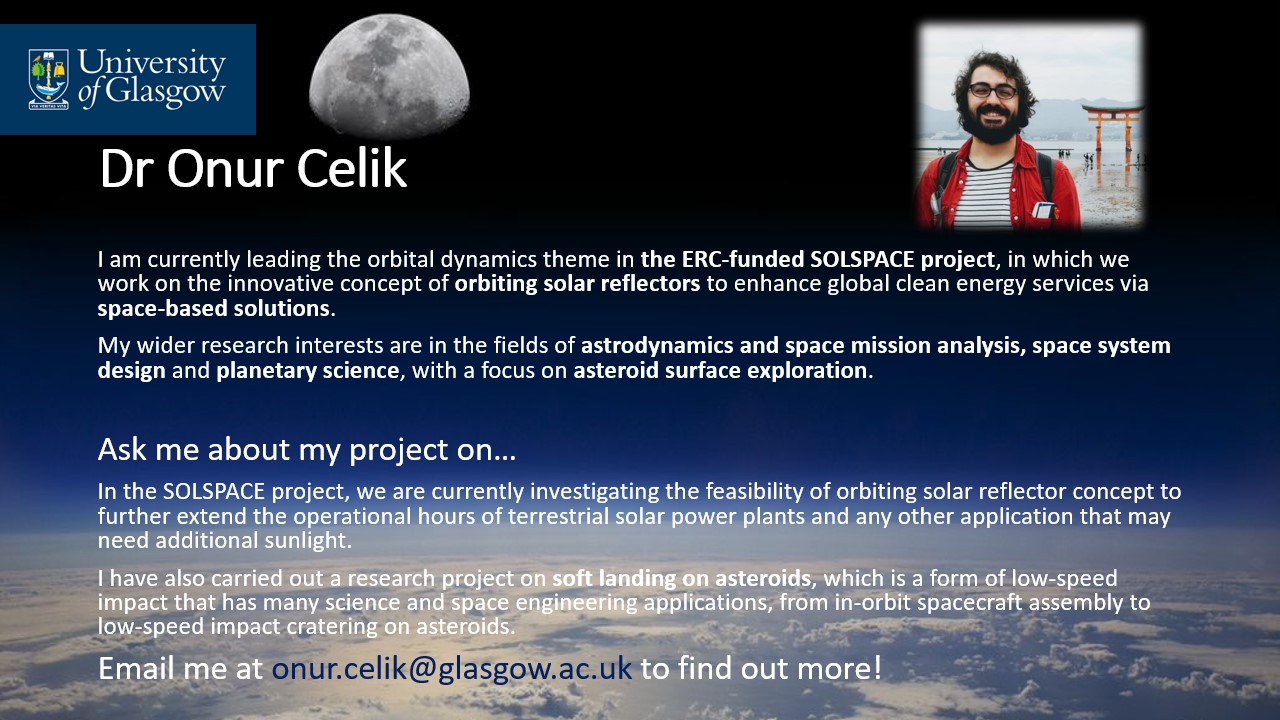
Dr Onur Celik
I am currently leading the orbital dynamics theme in the ERC-funded SOLSPACE project, in which we work on the innovative concept of orbiting solar reflectors to enhance global clean energy services via space-based solutions.
My wider research interests are in the fields of astrodynamics and space mission analysis, space system design and planetary science, with a focus on asteroid surface exploration.
SOLSPACE
In the SOLSPACE project, we are currently investigating the feasibility of orbiting solar reflector concept to further extend the operational hours of terrestrial solar power plants and any other application that may need additional sunlight.
I have also carried out a research project on soft landing on asteroids, which is a form of low-speed impact that has many science and space engineering applications, from in-orbit spacecraft assembly to low-speed impact cratering on asteroids.
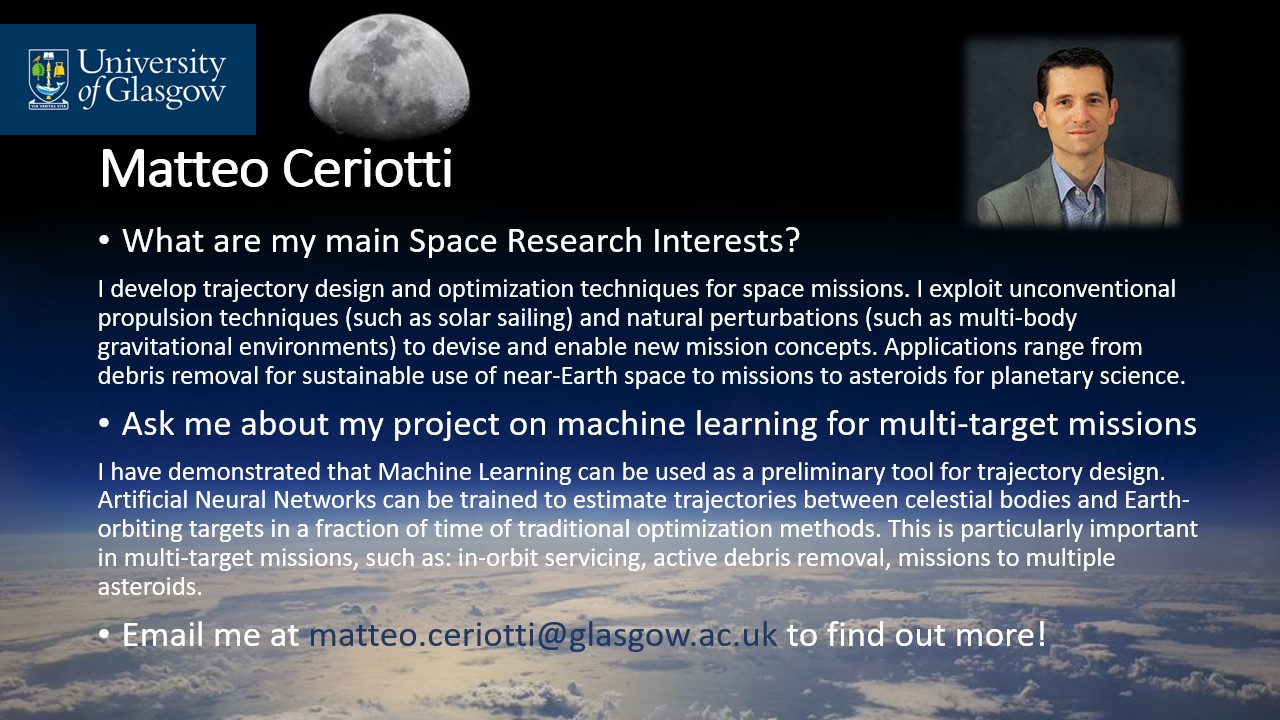
Dr Matteo Ceriotti
I develop trajectory design and optimization techniques for space missions. I exploit unconventional propulsion techniques (such as solar sailing) and natural perturbations (such as multi-body gravitational environments) to devise and enable new mission concepts. Applications range from debris removal for sustainable use of near-Earth space to missions to asteroids for planetary science.
Machine learning for multi-target missions
I have demonstrated that Machine Learning can be used as a preliminary tool for trajectory design. Artificial Neural Networks can be trained to estimate trajectories between celestial bodies and Earth-orbiting targets in a fraction of time of traditional optimization methods. This is particularly important in multi-target missions, such as: in-orbit servicing, active debris removal, missions to multiple asteroids.
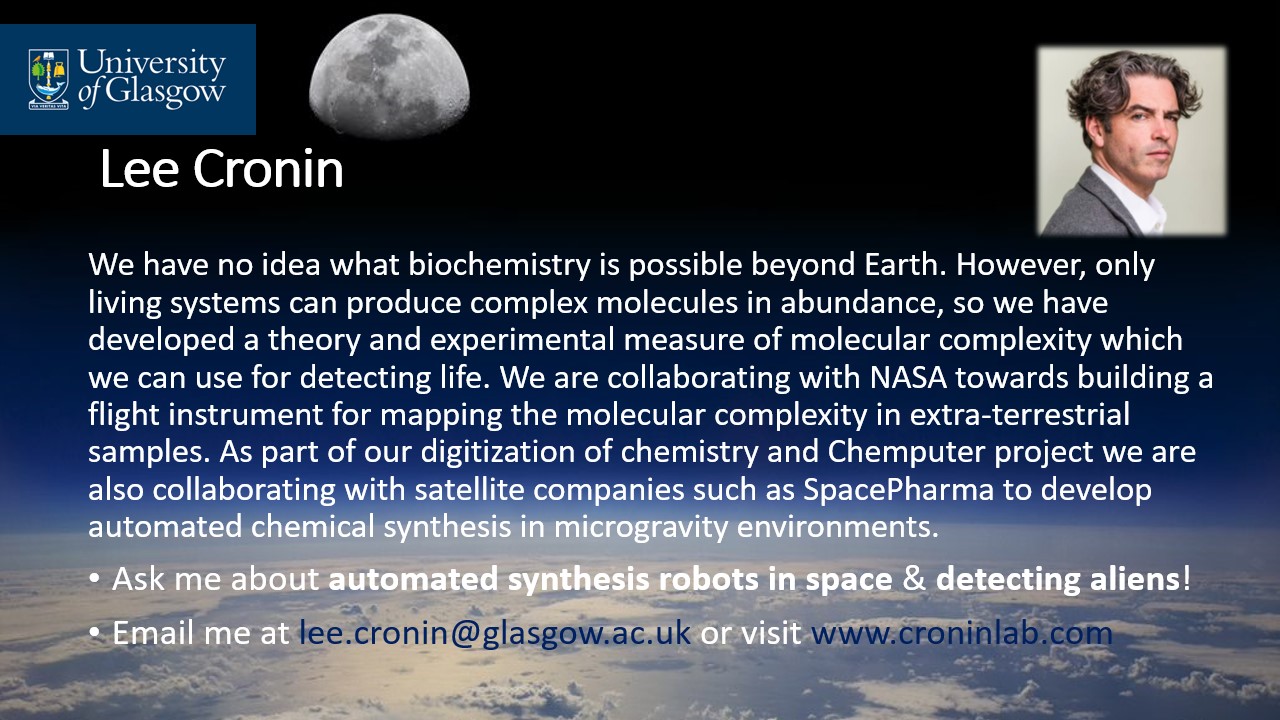
Professor Lee Cronin
We have no idea what biochemistry is possible beyond Earth. However, only living systems can produce complex molecules in abundance, so we have developed a theory and experimental measure of molecular complexity which we can use for detecting life. We are collaborating with NASA towards building a flight instrument for mapping the molecular complexity in extra-terrestrial samples. As part of our digitization of chemistry and Chemputer project we are also collaborating with satellite companies such as SpacePharma to develop automated chemical synthesis in microgravity environments.
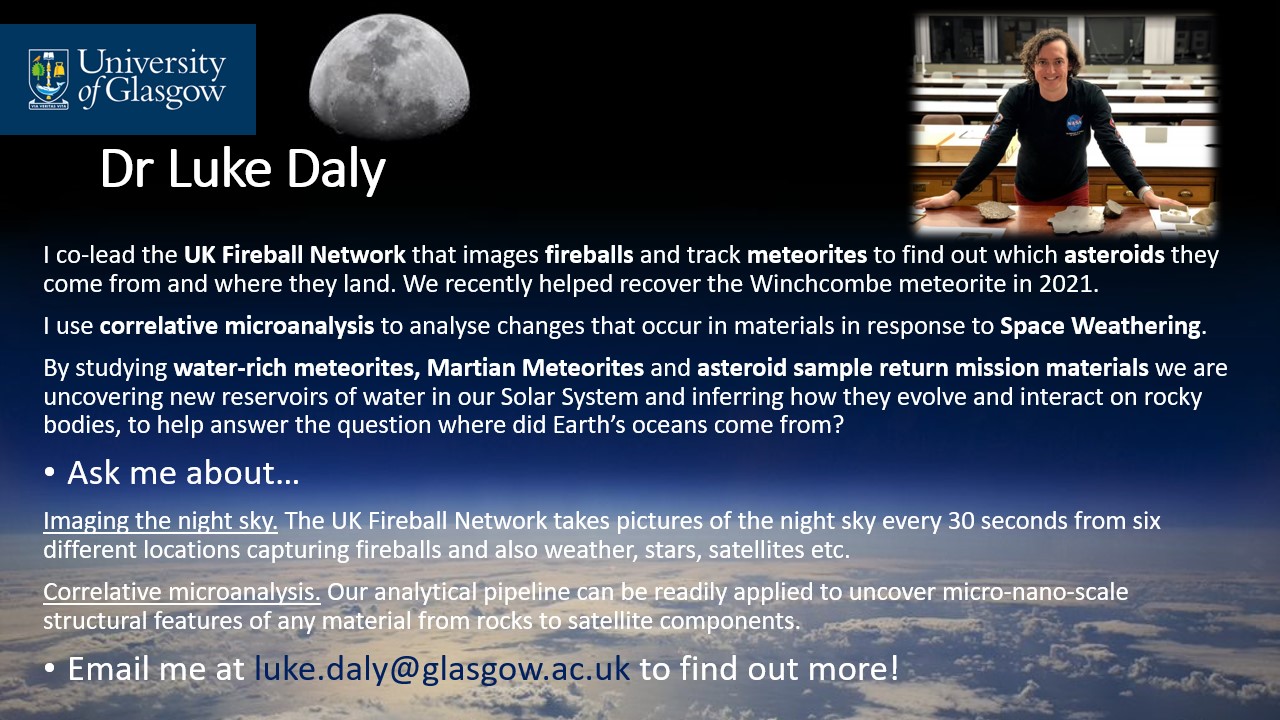
Dr Luke Daly
I co-lead the UK Fireball Network that images fireballs and track meteorites to find out which asteroids they come from and where they land. We recently helped recover the Winchcombe meteorite in 2021.
I use correlative microanalysis to analyse changes that occur in materials in response to Space Weathering.
By studying water-rich meteorites, Martian Meteorites and asteroid sample return mission materials we are uncovering new reservoirs of water in our Solar System and inferring how they evolve and interact on rocky bodies, to help answer the question where did Earth’s oceans come from?
Projects
- Imaging the night sky. The UK Fireball Network takes pictures of the night sky every 30 seconds from six different locations capturing fireballs and also weather, stars, satellites etc.
- Correlative microanalysis. Our analytical pipeline can be readily applied to uncover micro-nano-scale structural features of any material from rocks to satellite components.
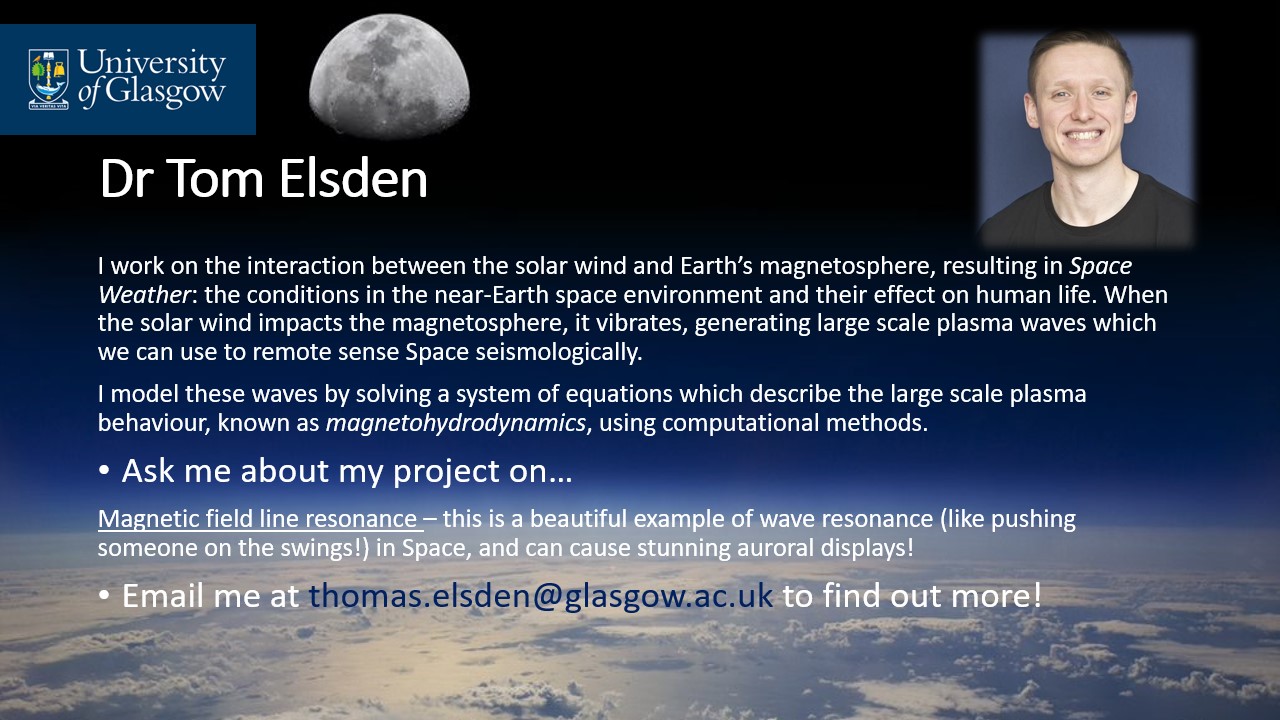
Dr Thomas Elsden
I work on the interaction between the solar wind and Earth’s magnetosphere, resulting in Space Weather: the conditions in the near-Earth space environment and their effect on human life. When the solar wind impacts the magnetosphere, it vibrates, generating large scale plasma waves which we can use to remote sense Space seismologically.
I model these waves by solving a system of equations which describe the large scale plasma behaviour, known as magnetohydrodynamics, using computational methods.
Project
Magnetic field line resonance – this is a beautiful example of wave resonance (like pushing someone on the swings!) in Space, and can cause stunning auroral displays!
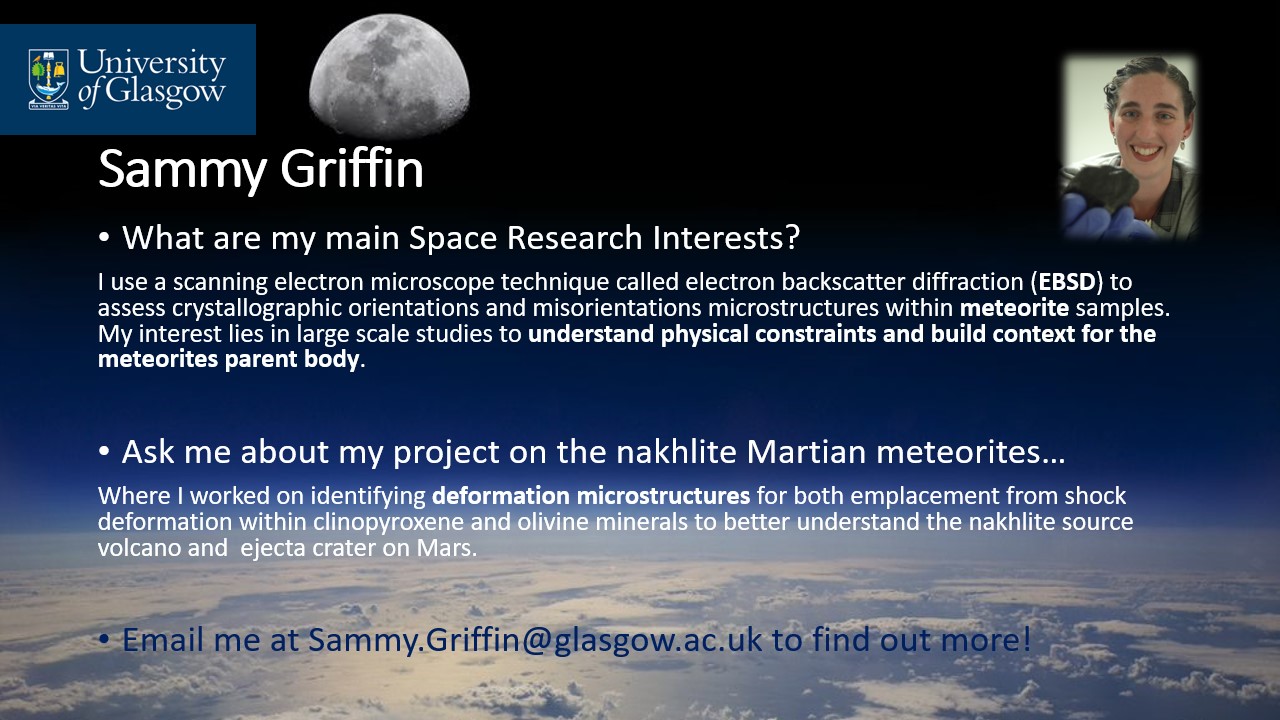
Dr Sammy Griffin
I use a scanning electron microscope technique called electron backscatter diffraction (EBSD) to assess crystallographic orientations and misorientations microstructures within meteorite samples. My interest lies in large scale studies to understand physical constraints and build context for the meteorites parent body.
Nakhlite Martian meteorites
Where I worked on identifying deformation microstructures for both emplacement from shock deformation within clinopyroxene and olivine minerals to better understand the nakhlite source volcano and ejecta crater on Mars.

Professor Patrick Harkness
I work on exploration hardware for extreme environments on Earth and in space, such as Antarctica and Mars; as well as space launch projects such an rocket engine development.
Projects
Polar drilling technologies and nanolauncher development.
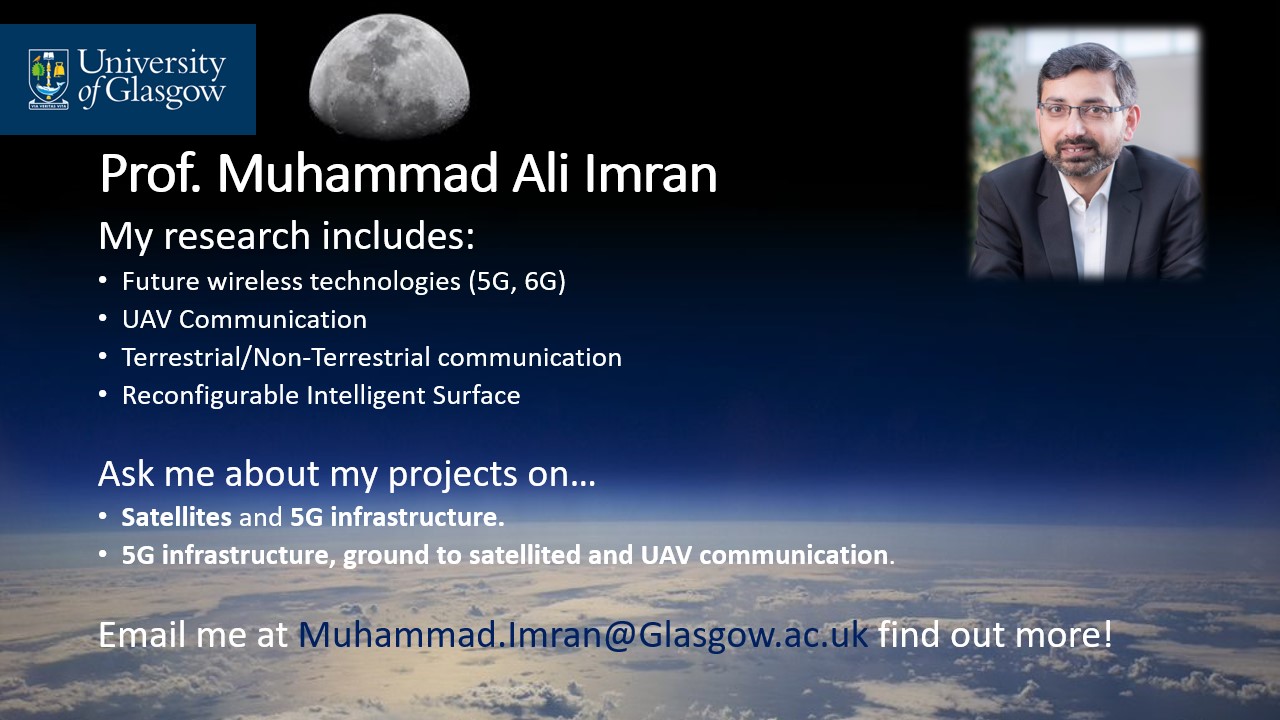
Professor Muhammad Imran
- Future wireless technologies (5G, 6G)
- UAV Communication
- Terrestrial/Non-Terrestrial communication
- Reconfigurable Intelligent Surface
Projects
- Satellites and 5G infrastructure.
- 5G infrastructure, ground to satellited and UAV communication.
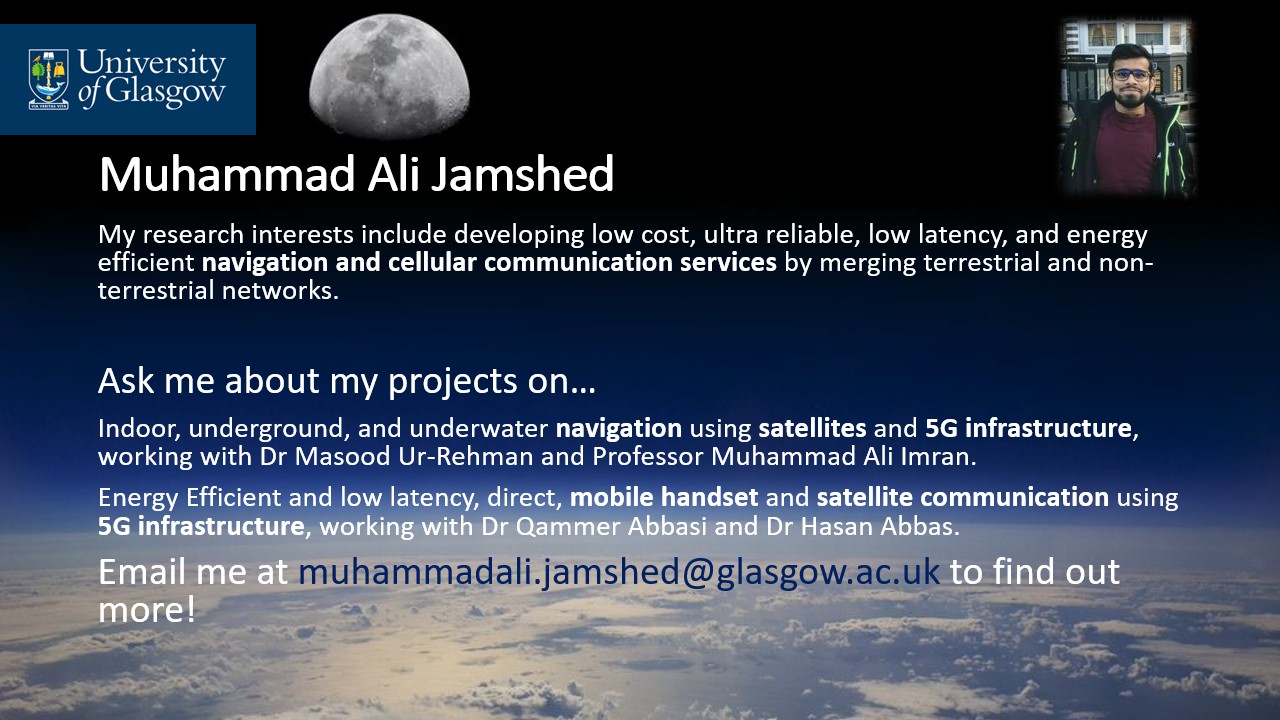
Dr Muhammad Ali Jamshed
My research interests include developing low cost, ultra reliable, low latency, and energy efficient navigation and cellular communication services by merging terrestrial and non- terrestrial networks.
Projects
Indoor, underground, and underwater navigation using satellites and 5G infrastructure, working with Dr Masood Ur-Rehman and Professor Muhammad Ali Imran.
Energy Efficient and low latency, direct, mobile handset and satellite communication using 5G infrastructure, working with Dr Qammer Abbasi and Dr Hasan Abbas.
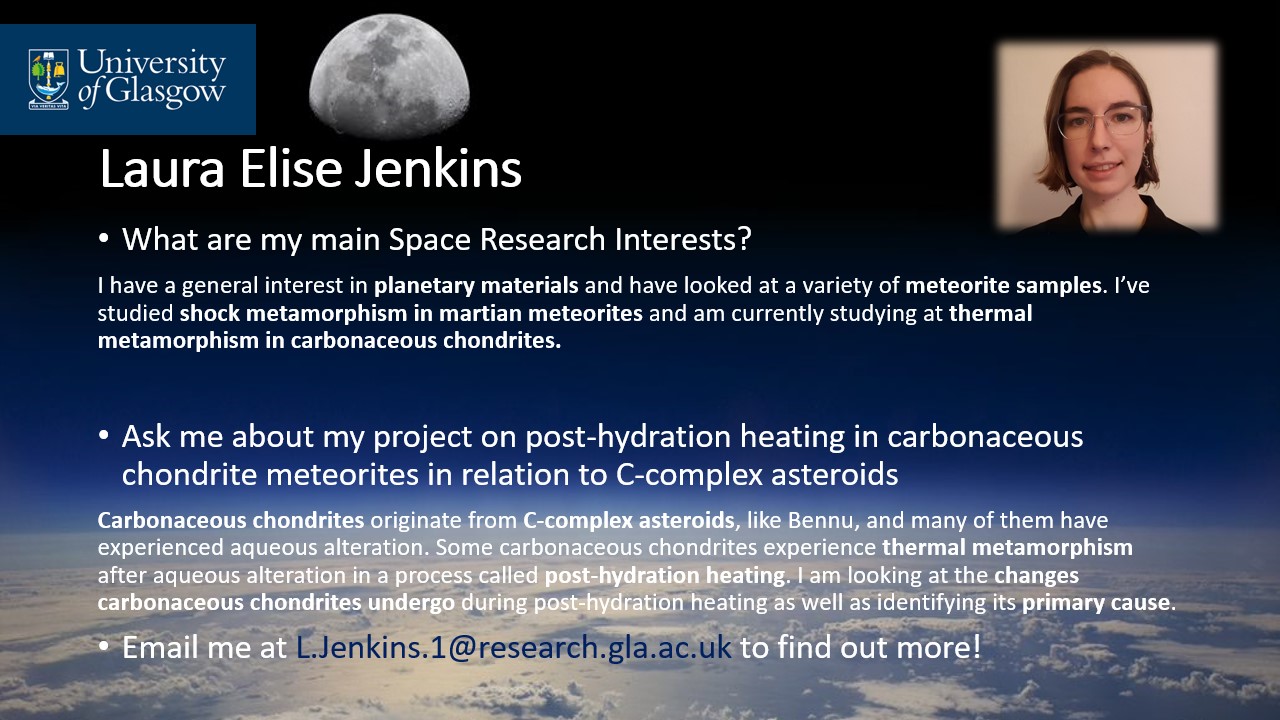
Laura Jenkins
I have a general interest in planetary materials and have looked at a variety of meteorite samples. I’ve studied shock metamorphism in martian meteorites and am currently studying at thermal metamorphism in carbonaceous chondrites.
Post-hydration heating in carbonaceous chondrite meteorites in relation to C-complex asteroids
Carbonaceous chondrites originate from C-complex asteroids, like Bennu, and many of them have experienced aqueous alteration. Some carbonaceous chondrites experience thermal metamorphism after aqueous alteration in a process called post-hydration heating. I am looking at the changes carbonaceous chondrites undergo during post-hydration heating as well as identifying its primary cause.
- Email me at L.Jenkins.1@research.gla.ac.uk to find out more
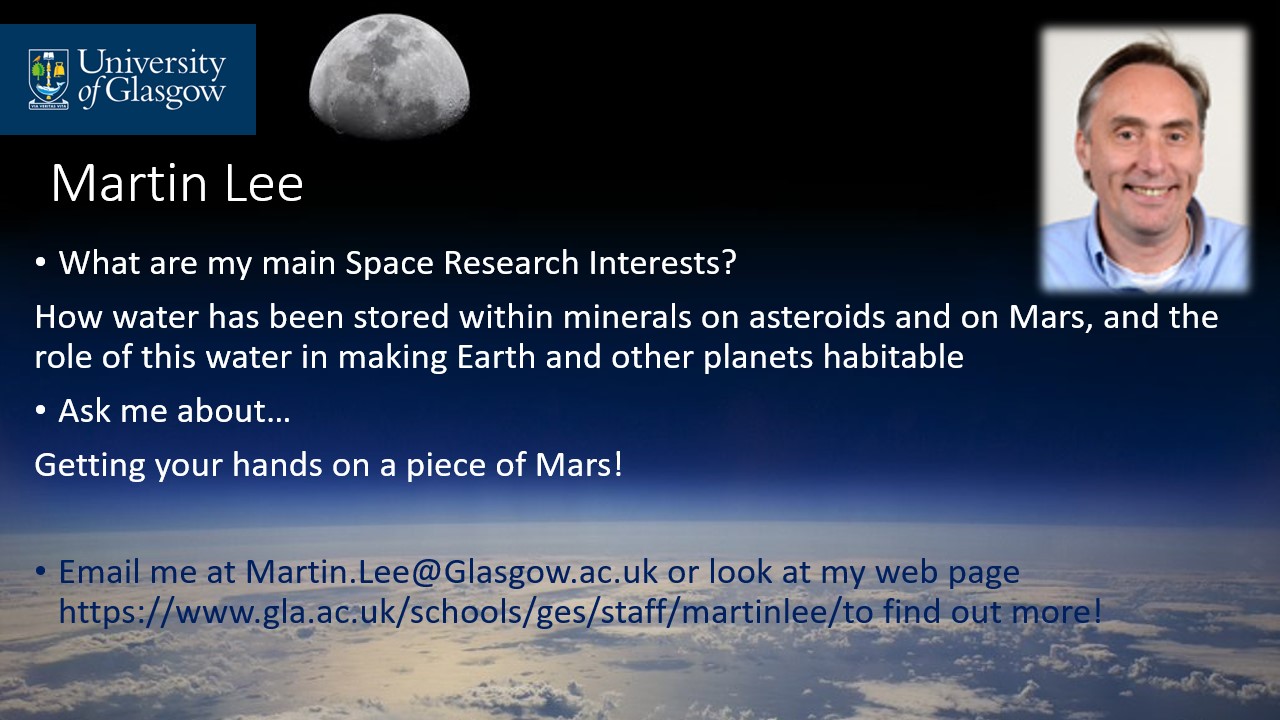
Professor Martin Lee
How water has been stored within minerals on asteroids and on Mars, and the role of this water in making Earth and other planets habitable
Ask me about…Getting your hands on a piece of Mars!

Dr David MacTaggart
I am interested in the dynamics of the solar atmosphere, particularly the interplay of the Sun’s magnetic field with large-scale plasma motions. Much of my recent work focusses on topological descriptions of the solar magnetic field and using these to understand and forecast the onset of flares are coronal mass ejections.
Predicting solar eruptions via magnetic winding
Magnetic winding is a description of magnetic connectivity which is showing much promise in providing both long- and short-term forecasts of strong solar flares. An important aim here is to produce forecasts with suitable lead times in order to mitigate the risks of space weather effectively.
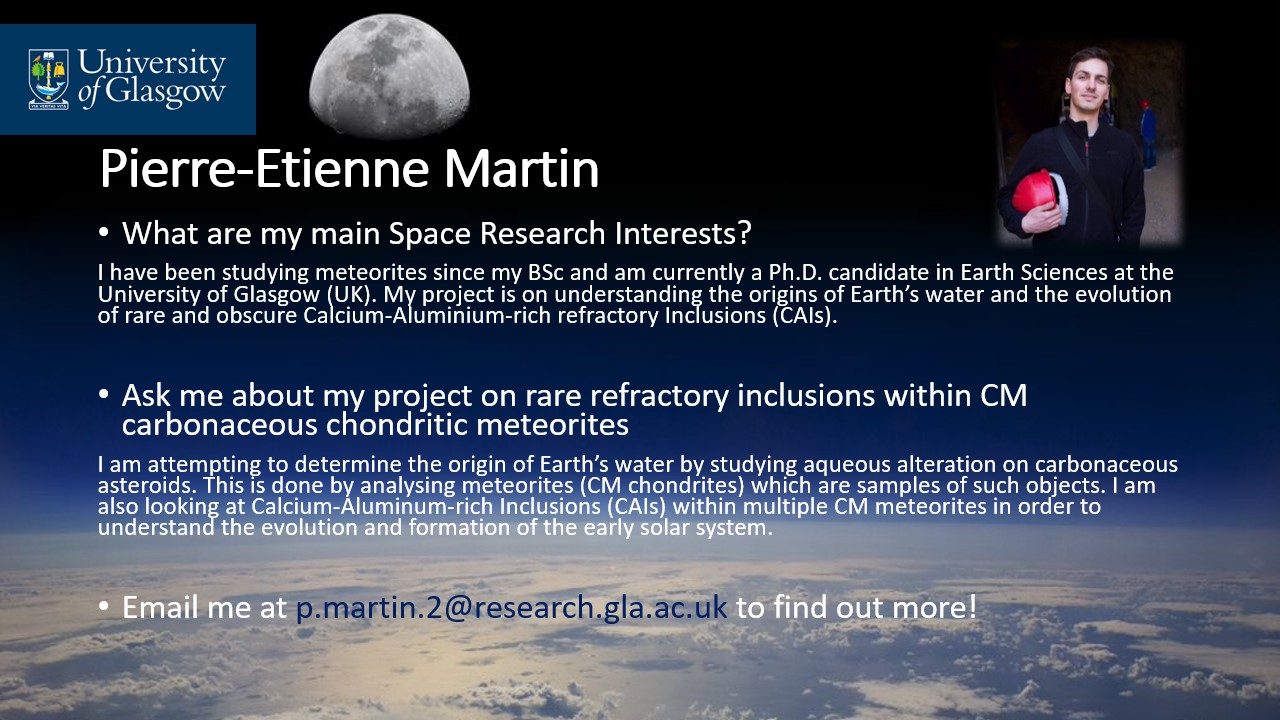
Pierre-Etienne Martin
I have been studying meteorites since my BSc and am currently a Ph.D. candidate in Earth Sciences at the University of Glasgow (UK). My project is on understanding the origins of Earth’s water and the evolution of rare and obscure Calcium-Aluminium-rich refractory Inclusions (CAIs).
Rare refractory inclusions within CM carbonaceous chondritic meteorites
I am attempting to determine the origin of Earth’s water by studying aqueous alteration on carbonaceous asteroids. This is done by analysing meteorites (CM chondrites) which are samples of such objects. I am also looking at Calcium-Aluminum-rich Inclusions (CAIs) within multiple CM meteorites in order to understand the evolution and formation of the early solar system.

Professor Colin McInnes
I have broad interests in emerging space technologies, from swarms of femto-satellites to in-orbit manufacturing of large space structures. This compliments work on the delivery of energy from space and utilising the material resources of near Earth asteroids. I have underpinning research interests in orbital dynamics, including work on novel orbits enabled by solar sail spacecraft.
Projects
MICRO-TO-MACRO: Through a Chair in Emerging Technologies from the Royal Academy of Engineering we are investigating space technologies at extremes of length-scale, and new the space applications enabled
SOLSPACE: Through an Advanced Grant from the European Research Council we are investigating the use of orbiting membrane solar reflectors to illuminate large terrestrial solar power plants at dawn and dusk

Aine O'Brien
I zap organic molecules in meteorites from Mars and elsewhere in the solar system to try understand whether Mars was ever/is habitable!
Ask me about: Helping find the first UK meteorite in the last 30 years!
Email me at a.obrien.1@research.gla.ac.uk or look at my website aineonmars.com to find out more
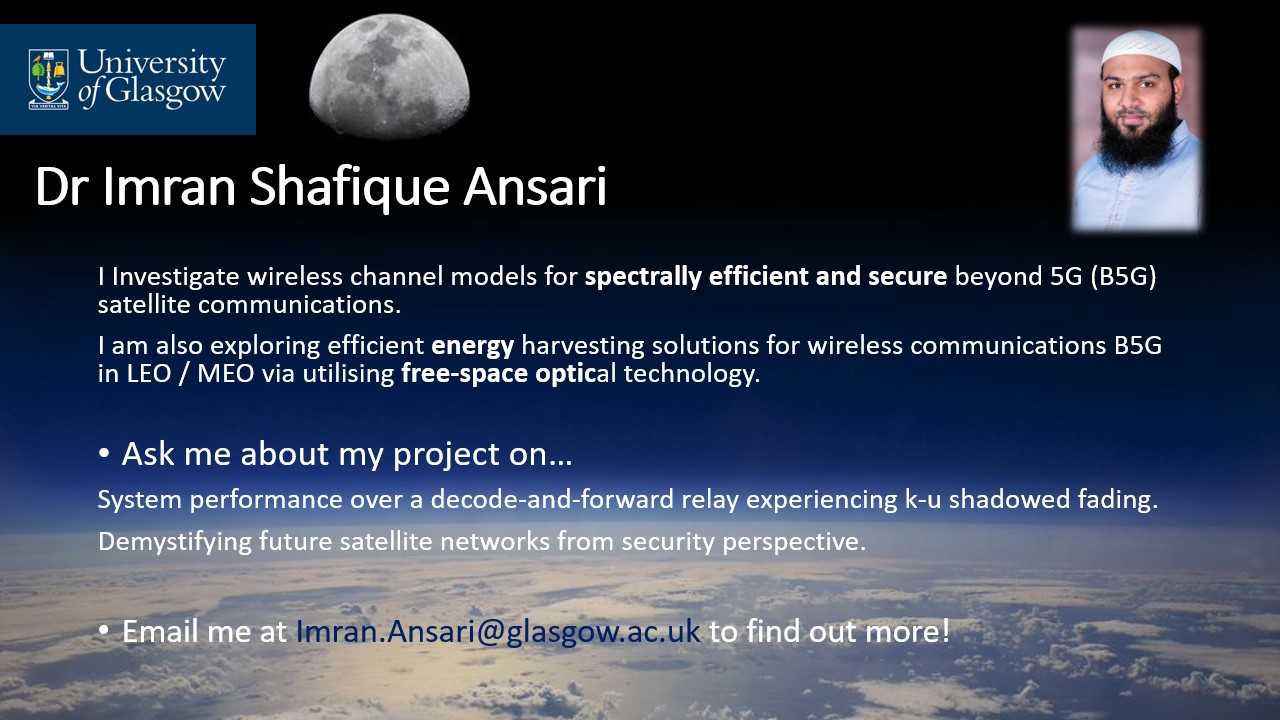
Dr Imran Shafique Ansari
I investigate wireless channel models for spectrally efficient and secure beyond 5G (B5G) satellite communications.
I am also exploring efficient energy harvesting solutions for wireless communications B5G in LEO / MEO via utilising free-space optical technology.
Projects
- System performance over a decode-and-forward relay experiencing k-u shadowed fading.
- Demystifying future satellite networks from security perspective.
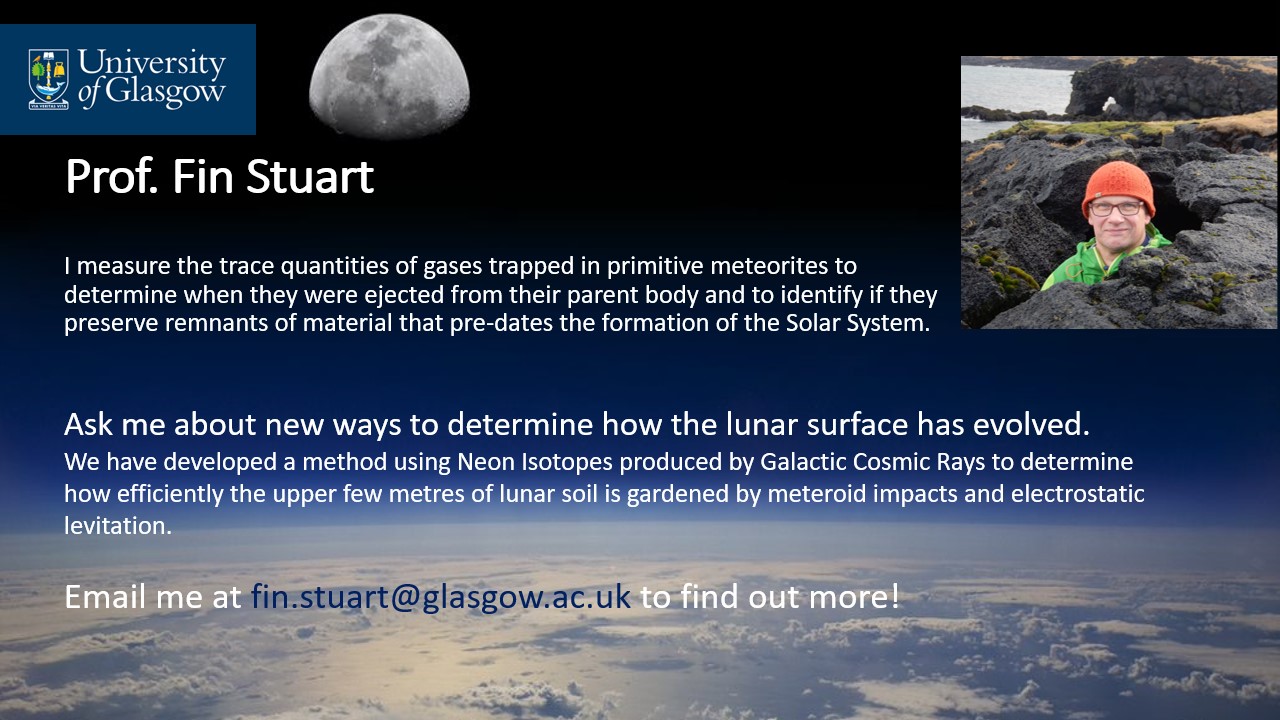
Professor Fin Stuart
I measure the trace quantities of gases trapped in primitive meteorites to determine when they were ejected from their parent body and to identify if they preserve remnants of material that pre-dates the formation of the Solar System.
Ask me about new ways to determine how the lunar surface has evolved. We have developed a method using Neon Isotopes produced by Galactic Cosmic Rays to determine how efficiently the upper few metres of lunar soil is gardened by meteroid impacts and electrostatic levitation.
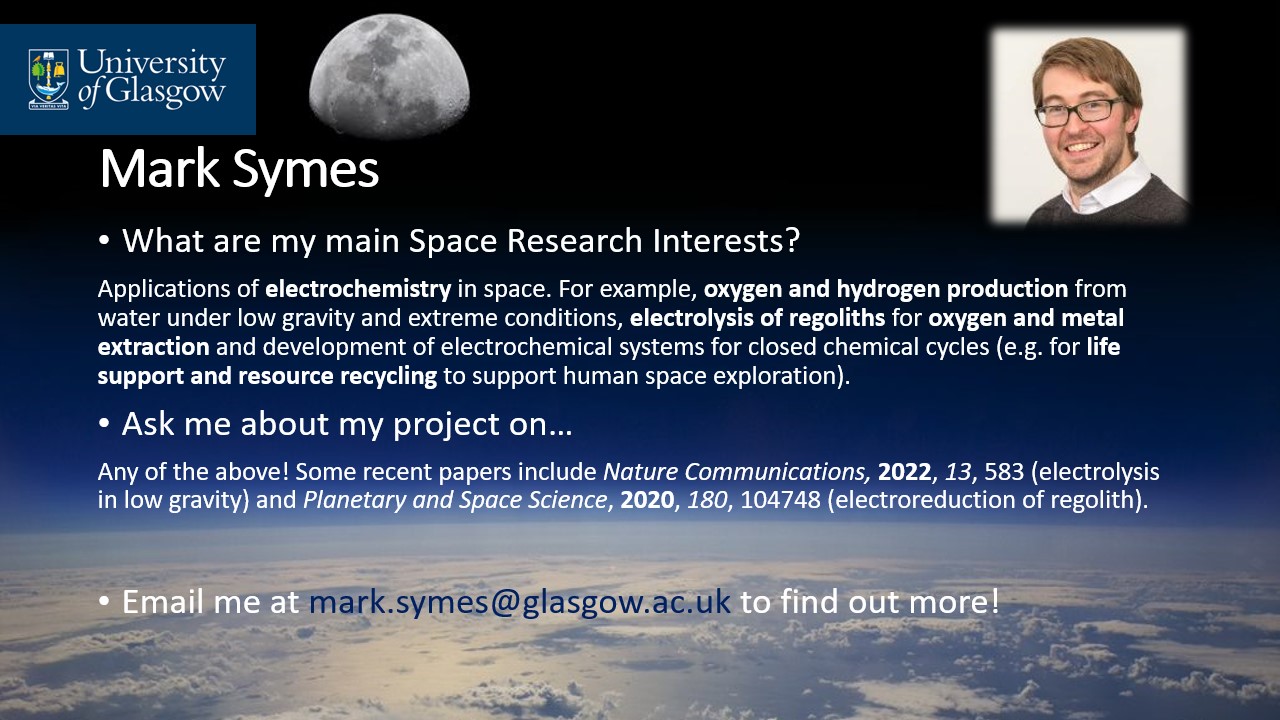
Dr Mark Symes
Applications of electrochemistry in space. For example, oxygen and hydrogen production from water under low gravity and extreme conditions, electrolysis of regoliths for oxygen and metal extraction and development of electrochemical systems for closed chemical cycles (e.g. for life support and resource recycling to support human space exploration).
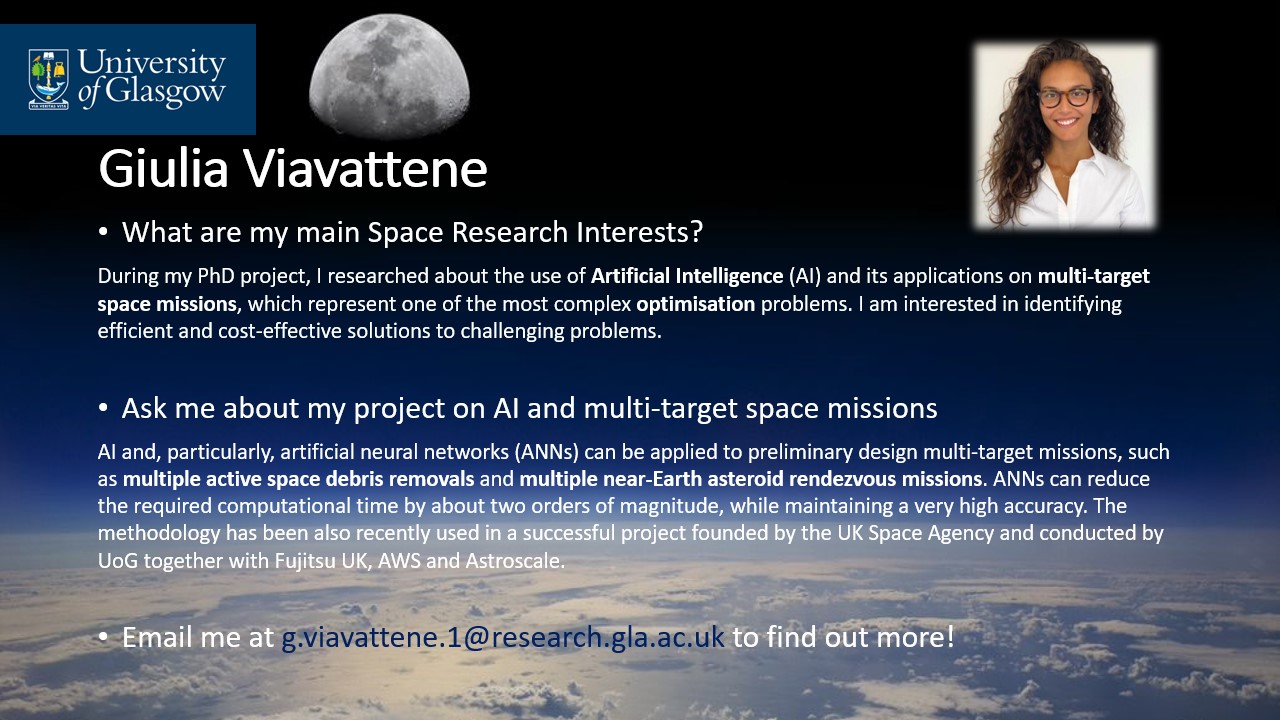
Giulia Viavattene
During my PhD project, I researched about the use of Artificial Intelligence (AI) and its applications on multi-target space missions, which represent one of the most complex optimisation problems. I am interested in identifying efficient and cost-effective solutions to challenging problems.
AI and multi-target space missions
AI and, particularly, artificial neural networks (ANNs) can be applied to preliminary design multi-target missions, such as multiple active space debris removals and multiple near-Earth asteroid rendezvous missions. ANNs can reduce the required computational time by about two orders of magnitude, while maintaining a very high accuracy. The methodology has been also recently used in a successful project founded by the UK Space Agency and conducted by UoG together with Fujitsu UK, AWS and Astroscale.
Email me at g.viavattene.1@research.gla.ac.uk to find out more

